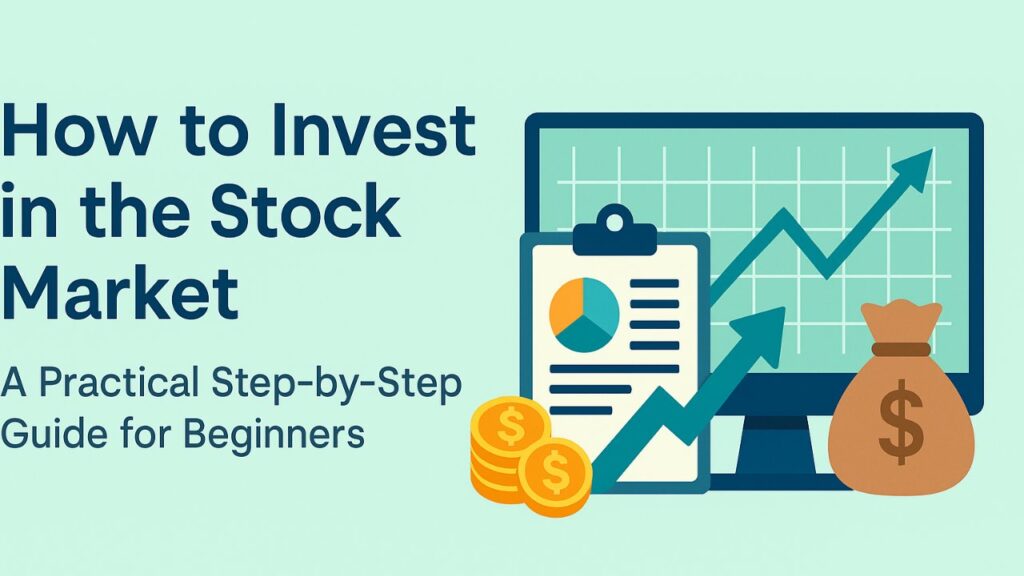How to Invest in the Stock Market

“The best investment you can make is in yourself. But learning how to invest in the stock market comes pretty close.” – Warren Buffett
If you’re curious about how to invest in the stock market but feel overwhelmed by all the jargon and risks, you’re not alone. Investing can be a powerful tool for building long-term wealth, but it’s important to approach it with clarity, purpose, and a solid plan.
This beginner-friendly guide breaks down the investment journey step by step — from understanding how markets work to making your first trade with confidence. Let’s get started.
Understanding the Stock Market
Before you make your first investment, it’s essential to understand what the stock market is and how it functions.
What Is the Stock Market?
The stock market is a network of exchanges where shares of publicly listed companies are bought and sold. When you buy a stock, you’re purchasing a small piece of ownership in a business. As the company grows or earns profits, your investment can increase in value.
How Does It Work?
- Companies go public by listing shares on stock exchanges (e.g., NYSE, NASDAQ in the U.S., NSE, BSE in India).
- Investors trade these shares through intermediaries called brokers.
- Prices fluctuate based on company performance, investor sentiment, economic indicators, and global events.
Understanding these fundamentals helps you make smarter investment choices.
Define Your Investment Goals
Jumping into the market without clear goals is like sailing without a compass. Here’s how to set yours:
- Purpose: Are you investing for retirement, a down payment, or wealth creation?
- Risk Tolerance: Can you handle short-term losses in pursuit of long-term gains?
- Timeline: Are your goals short-term (1–3 years) or long-term (5+ years)?
Your answers will shape your investment strategy.
Explore Investment Options
Let’s break down the most common stock market investment vehicles:
1. Individual Stocks
Investing in individual stocks means buying shares of a specific company, giving you partial ownership. These stocks have high potential returns because if the company performs well, your investment value can grow significantly. However, this approach requires regular research, monitoring company performance, and staying updated on market trends. Individual stocks are best suited for investors comfortable with higher risk and actively managing their portfolio.
- High potential returns
- Requires research and monitoring
- Suitable for risk-tolerant investors
2. Mutual Funds
Mutual funds pool money from many investors to buy a diversified portfolio of stocks, bonds, or other securities managed by professional fund managers. This option is ideal for beginners or those who prefer not to select individual stocks themselves. While mutual funds offer diversification and professional management, they often come with higher management fees compared to other investment options. They provide a balanced approach to risk and return.
- Professionally managed portfolios of stocks or bonds
- Ideal for beginners seeking diversification
- Higher management fees
3. Exchange-Traded Funds (ETFs)
ETFs combine the benefits of mutual funds and individual stocks. They hold a diversified portfolio like mutual funds but trade on stock exchanges like regular shares, allowing easy buying and selling throughout the day. ETFs generally have lower fees and better liquidity than mutual funds, making them an attractive choice for cost-conscious investors. They are flexible and accessible, suitable for both beginners and experienced investors.
- Diversified like mutual funds but trade like stocks
- Lower fees and more liquidity
4. Index Funds
Index funds are a type of mutual fund or ETF designed to replicate the performance of a specific market index, such as the S&P 500 or India’s Nifty 50. They offer broad market exposure, low costs, and require minimal maintenance, making them excellent for passive, long-term investors. Because they track the overall market, they reduce risk associated with picking individual stocks while still offering solid growth potential over time.
- Track a specific index (like S&P 500 or Nifty 50)
- Great for passive, long-term investing
- Low maintenance and low cost
5. Bonds
Bonds are fixed-income investments where you lend money to corporations or governments in exchange for regular interest payments plus the return of principal at maturity. They typically carry lower risk than stocks, but with correspondingly lower returns. Bonds are a good choice for conservative investors seeking steady income and capital preservation. They help balance the risk in your portfolio, especially during volatile market conditions.
- Fixed-income investments (corporate or government)
- Lower risk but lower returns
- Best for conservative investors
| Investment Type | Risk Level | Returns | Good For |
|---|---|---|---|
| Stocks | High | High | Active investors |
| Mutual Funds | Medium | Moderate | Beginners |
| ETFs | Low-Med | Moderate | Cost-conscious investors |
| Index Funds | Low-Med | Moderate | Long-term savers |
| Bonds | Low | Low | Risk-averse investors |
Choosing the Right Stockbroker
To begin investing, you need a brokerage account. Here’s how to choose wisely:
Full-Service Brokers
- Offer personalized advice and research tools
- Higher fees (e.g., ICICI Direct, HDFC Securities)
Discount Brokers
- Low-cost platforms for self-directed investors
- Popular choices: Zerodha, Upstox, Angel One
Tips for Selecting a Broker:
- Compare fees and commissions
- Test the trading platform’s user experience
- Review customer support and mobile app quality
- Ensure access to the markets and instruments you want
Once selected, open a Demat and Trading account to start investing.
How to Research Stocks
Blindly buying stocks is like gambling. Instead, analyze before you invest:
Fundamental Analysis
- Financials: Check revenue, profits, earnings per share
- Debt Levels: Favor companies with manageable debt
- Leadership: Look for experienced and transparent management
- Competitive Advantage: Does the company stand out in its industry?
Technical Analysis
- Use price charts and volume indicators
- Learn patterns like Moving Averages, RSI, and MACD for entry/exit points
This dual approach helps you spot quality investments and avoid bad ones.
Making Your First Investment: A Step-by-Step Walkthrough
Here’s what your first trade might look like:
- Log in to your broker’s platform
- Search for the stock by name or ticker
- Choose the order type:
- Market Order: Buy at current price
- Limit Order: Set your preferred price
- Enter the number of shares
- Review and confirm the order
🎉 You’re now officially an investor!
Managing Your Portfolio Post-Investment
Investing isn’t a one-time action—it’s an ongoing process:
- Track Performance: Monitor gains and losses regularly
- Rebalance: Adjust your holdings to stay aligned with your goals
- Stay Informed: Keep up with company news, quarterly results, and market trends
- Exit Strategically: Set target prices for profit-taking or stop-losses
Common Pitfalls to Avoid
Even seasoned investors make mistakes. Here are common traps beginners should sidestep:
- 📉 FOMO Investing: Don’t chase trends without research
- 🚫 Lack of Diversification: Spread your risk across sectors
- ❗ Emotional Decisions: Stick to your strategy, not your fears
- 💰 Ignoring Costs: Account for fees, taxes, and inflation
- 📚 Skipping the Learning Curve: Keep educating yourself continuously
Long-Term vs. Short-Term Strategies
Your approach should match your financial goals:
Long-Term Investing
- Ideal for wealth building through compounding
- Less affected by short-term volatility
Short-Term Trading
- Higher risk and requires more time and skill
- Suitable only if you’re experienced and disciplined
💡 Beginner Tip: Start with a long-term mindset to build a solid foundation.
Final Thoughts
Investing in the stock market can transform your financial future—but only if done thoughtfully. Begin with clear goals, build your knowledge gradually, and start small. With patience, consistency, and a long-term perspective, you’ll be well on your way to financial freedom.
🚀 Ready to get started? Open a brokerage account today and begin your journey toward smart investing.



